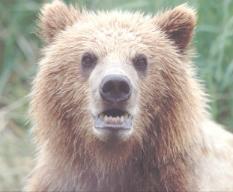In the back-and-forth volley over grizzly bear protection in the Yellowstone National Park ecosystem, U.S. District Judge Donald Molloy reinstated Threatened species protection for the bears under the Endangered Species Act (ESA) on November 17, 2009. Two years earlier the U.S. Fish and Wildlife Service had de-listed the grizzlies in Yellowstone, saying the population had recovered and no longer needed federal protection. In September 2009, Judge Molloy ordered the bears back on Threatened status sighting that decrease in food sources such as white bark pine seeds (from climate change among other things), and lax state management regulations put the bear’s survival in jeopardy.
The November ruling puts to rest an appeal by the US Fish and Wildlife Service to release the bear from federal ESA protection. The appeal was supported by Wyoming’s Game and Fish Department as well as U.S. Sens. Mike Enzi, R-Wyo and John Barrasso, R-Wyo and Rep. Cynthia Lummis, R-Wyo. "To be honest, our concern up to this point was whether bear numbers in Wyoming were getting too big," said Wyoming governor Dave Freudenthal. Yellowstone grizzly numbers are estimated at about 600, up from 200 when the bears were originally listed in 1975.
“It is good that we have more bears,” said Louisa Willcox, director of the Natural Resources Defense Council’s Wild Bears Project. “But even the federal government’s own computer models aren’t optimistic about the bears’ fate a century from now.” Several disturbing trends are coming together, she said. While housing and energy development in the counties surrounding Yellowstone are accelerating, key food sources (ungulate meat, whitebark pine nuts, cutthroat trout and army cutworm moths) are threatened and/or declining. This one-two punch of less habitat and less food could be devastating to the bears’ long-term survival, said Willcox. “We’re going to have less room for the bears just when they need more room to compensate for less food,” she said.
White bark pine seeds, for instance, are a critical food source for grizzly bears in the Rocky Mountains. The number of cubs a female will produce has been correlated to the availability of white bark pine seeds. This food source provides an important source of fats and protein at a critical time in the female’s reproductive cycle.
The ruling is expected to be appealed by the US Fish and Wildlife Service.
By Julie Hopkins, with excerpts by Brodie Farquhar for Yellowstone Journal Corporation/ YellowstonePark.com, 2006)


